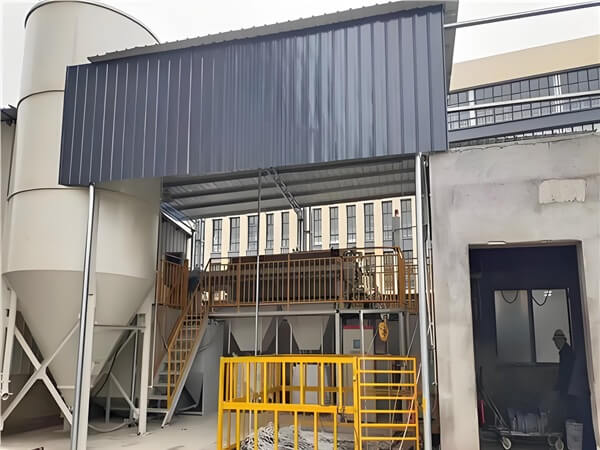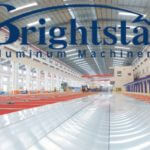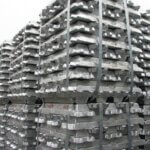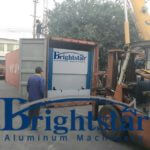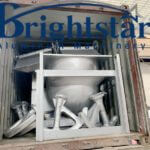Top 3 factors that affect aluminum extrusion dies cleaning and washing efficiency
Top 3 factors that affect aluminum extrusion dies cleaning and washing efficiency
Introduction
The extrusion die is a key component in the aluminum extrusion production process.
When the die is removed after the extrusion machine is used, a certain amount of scrap aluminum will be stuck in the die hole, affecting the repair and reuse of the die.
The extrusion die cleaning process is to use a crane or hoist to lift the die into an alkali tank filled with sodium hydroxide solution.
After the scrap aluminum adhering to the die hole is partially dissolved, the die is cleaned and the scrap aluminum is knocked out.
The cleaned die is then repaired or put back into use.
The cleaning process of aluminum extrusion dies will produce waste liquid containing alkali and aluminum.
Why is it necessary to carry out the aluminum extrusion die cleaning process?
The role of aluminum extrusion dies cleaning process
Aluminum extrusion dies are tools used to manufacture metal products.
They are used frequently, and their service life and performance are related to product quality and production efficiency.
However, aluminum extrusion die may have process defects such as cracking and breaking during the production process.
In order to eliminate these defects, improve the hardness and toughness of aluminum extrusion die, and extend the service life of the die, it is necessary to clean and wash aluminum extrusion dies.
Principle of extrusion die cleaning and washing
The material of extrusion die is generally alloy steel.
After quenching and tempering, its hardness and toughness can be greatly improved, and it has good wear resistance and corrosion resistance.
However, due to the complex internal structure and shape of the die, it is difficult to process and may cause some process defects.
Aluminum extrusion die cleaning and washing can further improve the microstructure of the die, eliminate stress concentration inside the die, and improve the strength and toughness of the die surface, thereby reducing deformation and damage of the die during the extrusion process.
Aluminum extrusion dies cleaning and washing details
1. Preparation of the die cleaning and washing tank
The cleaning and washing process of aluminum extrusion dies requires a cleaning and washing tank.
First, ensure that the alkaline water concentration in the tank is appropriate and not too concentrated, and heat it.
During the heating process, be careful to prevent the alkaline water from splashing out and injuring people.
2. Safe placement of aluminum extrusion dies
When placing the dies to be cleaned and washed in the tank, pay attention to safety to avoid splashing of alkaline water and injuring people.
At the same time, make sure that the dies are placed in a stable position without tilting or sliding.
3. Disassemble the dies
After the die is cleaned and washed for a certain period of time, the porthole die needs to be disassembled.
During this process, be careful not to damage the dies and try to take out the aluminum scraps that is stuck in the die to reduce unnecessary aluminum loss.
4. Cleaning the dies
After the die is washed, rinse it with clean water and send it to the die repair workshop.
5. Timeliness of the die cleaning and washing
The die cleaning and washing process should be timely.
The dies used during the shift should not stay on the machine for more than 1 hour.
Urgent aluminum extrusion dies need to be cleaned and washed immediately.
Therefore, during the production process, the time for aluminum extrusion dies should be reasonably arranged to ensure production efficiency and the service life of the molds.
The current situation of extrusion die cleaning
The process of aluminum extrusion dies cleaning is to immerse the die in a sodium hydroxide solution, which will dissolve the aluminum metal, thus making the die clean and easy to use again.
However, the sodium hydroxide solution will quickly enrich the dissolved aluminum.
As it continues to dissolve more aluminum, its dissolving ability decreases until it is completely lost, so the sodium hydroxide solution must be replaced frequently.
During the extrusion die cleaning process, the waste aluminum in the die hole undergoes the following chemical reactions in the sodium hydroxide solution:
Removal of the natural oxide film of aluminum: Al2O3+2NaOH==2NaAlO2+H2O(g)↑ (water vapor)
Dissolved aluminum: 2Al+2NaOH+2H2O==2NaAlO2+3H2↑
Solution decomposition: NaAlO2+2H2O==Al(OH)3↓+NaOH
In actual production, the mass concentration of sodium hydroxide in the extrusion die cleaning process is about 200g/L~300g/L (mass fraction is about 16.7%~23.1%), and the peak temperature of the die cleaning process can reach 100°C.
The extrusion die cleaning time depends on the specific conditions of the die (die type, die size, whether the extrusion die is urgently needed, etc.).
The following are the main problems encountered by extrusion die cleaning operation in their daily production operations:
1. Unorganized and unplanned addition of sodium hydroxide, resulting in high consumption of sodium hydroxide;
2. Replacing sodium hydroxide solution based on experience, resulting in serious waste;
3. Prolonging extrusion dies cleaning time to save trouble.
An extrusion factory with an annual output of 200,000 tons of aluminum profiles consumes about 2,000 tons of sodium hydroxide in the extrusion die cleaning process, and produces about 8,000 tons of dies cleaning waste liquid containing alkali and aluminum.
The extrusion dies cleaning process consumes a large amount of sodium hydroxide, and a large amount of acid is also required to treat a large amount of mold-making waste liquid.
Brightstar Aluminum Machinery’s waste alkali liquid recycling and regeneration system integrates the functions of aluminum extrusion dies cleaning and washing, crystallization, solid-liquid separation, etc.
The product is controlled by PLC + touch screen, with a high degree of automation and simple operation.
The equipment can effectively reduce the customer’s use of caustic soda and tap water and can achieve zero emissions, saving both the cost of use and the cost of hazardous waste treatment.
The process flow of the waste alkali liquid regeneration system for aluminum extrusion dies cleaning and washing: extrusion dies cleaning and washing (spray tower to treat waste gas), cleaning, automatic circulation pumping, automatic stirring, automatic solid-liquid separation.
The separated solid is aluminum hydroxide crystal, which is the raw material of water purifier and can be sold;
The separated liquid (regeneration alkali can be recycled to extrusion dies cleaning and washing tank) and the remaining part of the liquid returns to the crystallization tank for crystallization.
The whole process does not produce any hazardous waste.
Experimental Research
Based on the observation and understanding of the actual production situation of the extrusion dies cleaning process, combined with the chemical reactions that occur in the extrusion dies cleaning process, the factors that have a greater impact on the dies cleaning efficiency are:
1. Dies cleaning time;
2. Sodium hydroxide concentration;
3. Dies cleaning temperature.
Therefore, the experiment is mainly conducted based on these three factors, and the changes in the concentration of each substance in the dies cleaning waste liquid are explored.
Effect of reaction time on dissolving aluminum metal
Effect of reaction time on dissolving aluminum metal, take 7 small cylindrical aluminum rods (diameter D=21mm, length L=100mm), weighing 92.3±0.1g, and prepare 7 portions of 500mL sodium hydroxide solution with a mass concentration of 300g/L.
The aluminum rods were placed in the sodium hydroxide solution for 1, 2, 3, 4, 5, 6, and 12 hours respectively.
After reaching the target time, measure the total alkali concentration, free sodium hydroxide concentration, aluminum ion concentration and solution temperature of the solution.
Take out the aluminum rods, wipe them clean with filter paper, and weigh the aluminum rods.
The experimental phenomena are as follows:
(1) Bubbles emerge from the surface of the aluminum rods. The number of bubbles increases gradually at first and then decreases after some time;
(2) The solution releases heat during the reaction. The solution gradually heats up to boiling at first and stops boiling after some time;
(3) The color of the solution gradually changes from white to gray. As the reaction time increases, the color of the solution deepens and becomes more turbid;
(4) The liquid level of the solution gradually decreases;
(5) A gray-black precipitate is generated at the bottom of the solution and gradually increases.
As the reaction time increases, the total alkali concentration increases.
This is because aluminum reacts with sodium hydroxide solution to form sodium aluminate, and the sodium aluminate hydrolyzes: AlO2-+2H2O Al(OH)3+OH-, making the solution strongly alkaline.
In addition, the solution contains unconsumed sodium hydroxide, so the total alkali concentration continues to increase.
As the reaction time increases, the free sodium hydroxide concentration gradually decreases, and the aluminum ion concentration gradually increases.
After about 3 hours of reaction, the changes in the free sodium hydroxide concentration and the aluminum ion concentration tend to be stable.
This is because as the reaction time increases, more and more aluminum is enriched and dissolved in the sodium hydroxide solution, and the aluminum ion concentration increases.
When more aluminum continues to be dissolved, the solubility of the sodium hydroxide solution gradually decreases, so the rate of change of the free sodium hydroxide concentration and the aluminum ion concentration gradually decreases.
When the aluminum rods comes into contact with the sodium hydroxide solution, the temperature of the solution rises.
This is because the dissolution of sodium hydroxide in water is an exothermic physical reaction, and the reaction of aluminum with the sodium hydroxide solution is an exothermic chemical reaction, which causes the solution temperature to rise to boiling, and then the temperature gradually decreases.
As the reaction time increases, the weight of the aluminum rod gradually decreases.
After about 3 hours of reaction, the change in the weight of the aluminum rod tends to be stable.
This is because as the reaction time increases, the solubility of the sodium hydroxide solution gradually decreases, so the reaction rate of the aluminum rod and the sodium hydroxide solution gradually decreases.
Within about 3 hours after the reaction started, the aluminum rod reacted with the sodium hydroxide solution at a faster speed;
After about 3 hours, the aluminum rod reacted with the sodium hydroxide solution at a slower speed, which was significantly reduced compared with the speed of the aluminum rod reacting with the sodium hydroxide solution within about 3 hours after the reaction started.
Considering the actual production situation, the extrusion dies cleaning time is controlled at about 3 hours, and the dies cleaning efficiency is relatively high.
Extending the extrusion dies cleaning time has no obvious effect on the dissolution of waste aluminum.
Effect of sodium hydroxide concentration on the dissolution of aluminum metal
Take 5 pieces of small cylindrical aluminum rods (diameter D=21mm, length L=100mm), weighing 92.3±0.1g, and prepare 5 portions of 500mL sodium hydroxide solution with mass concentrations of 210g/L, 240g/L, 270g/L, 300g/L, and 330g/L, respectively.
Take 5 pieces of aluminum rods and place them in the sodium hydroxide solution respectively, and immediately mark the liquid level on the beaker wall with a marker.
Every hour, take out the aluminum rod, wipe it clean with filter paper, and weigh it.
Then put the aluminum rod back into the sodium hydroxide solution and add normal temperature tap water to the mark.
The higher the sodium hydroxide concentration, the faster the weight of the aluminum rod decreases.
From the effect of reaction time on the dissolution of aluminum metal, it can be seen that the efficiency of dissolving aluminum metal is higher when the reaction time is controlled at about 3 hours.
When the reaction time is 3 hours, the weight reduction of the 5 pieces of aluminum rods with the above concentrations of 210g/L, 240g/L, 270g/L, 300g/L, and 330g/L is 26.84g, 37.82g, 42.19g, 49.91g, and 53.63g respectively.
The weight reduction of aluminum rods with adjacent concentrations that have reacted for 3 hours is subtracted and the absolute value is taken, which is: 10.98g, 4.37g, 7.72g, and 3.72g respectively.
When the reaction time is 3 hours, the weight reduction of the aluminum rod in the sodium hydroxide solution with a concentration of 240g/L is much greater than that of the aluminum rod in the sodium hydroxide solution with a concentration of 210g/L (10.98g).
Therefore, it is recommended to use a sodium hydroxide solution with a concentration of ≥240g/L to dissolve aluminum metal;
When the reaction time is 3 hours, the weight reduction of the aluminum rod in the sodium hydroxide solution with a concentration of 330g/L is much less than that of the aluminum rod in the sodium hydroxide solution with a concentration of 300g/L (3.72g).
Therefore, it is recommended to use a sodium hydroxide solution with a concentration of ≤300g/L to dissolve aluminum metal.
In actual production, considering the dissolution rate of scrap aluminum and production cost, it is recommended to use sodium hydroxide solution with a mass concentration of 240g/L to 300g/L for extrusion die cleaning.
Effect of reaction temperature on the dissolution of aluminum metal
Take 2 small pieces of cylindrical aluminum rods (diameter D = 21mm length L = 100mm), weighing 92.3±0.1g, and prepare 2 portions of 500mL sodium hydroxide solution with mass concentrations of 150g/L and 300g/L respectively.
Place the beaker in a constant temperature water bath heating device and set the temperature to 90℃.
Take 2 pieces of aluminum rods and place them in sodium hydroxide solution respectively, and immediately mark the liquid level on the beaker wall with a marker.
Take out the aluminum rods every 1 hour, wipe them clean with filter paper, and weigh them.
Then put the aluminum rods back into the sodium hydroxide solution and add room-temperature tap water to the mark.
Raising the temperature of the sodium hydroxide solution will significantly accelerate the rate of weight reduction of the aluminum rods.
After the low-concentration sodium hydroxide solution is heated, the weight reduction rate of the aluminum rods can, to a certain extent, reach the weight reduction rate of the aluminum rods in the high-concentration sodium hydroxide solution at room temperature.
As the weight reduction rate of the aluminum rods increases, the evaporation rate of water also increases.
In actual production, the extrusion dies cleaning alkali tank can be properly heated, and attention should be paid to timely replenishing water to avoid the sodium hydroxide solution level being lower than the mold, thereby affecting the extrusion dies cleaning efficiency.
When supplementing water, the cost should be comprehensively considered, and high-temperature water generated during production in other processes should be added as much as possible to further accelerate the dissolution rate of scrap aluminum.
In summary: the aluminum extrusion dies cleaning process should be based on the chemical reaction that occurs during the washing and cleaning process.
The factors that have a greater impact on the die cleaning efficiency are:
1. Dies cleaning time; 2. Sodium hydroxide concentration; 3. Dies cleaning temperature.
Comprehensive consideration can make the extrusion dies cleaning efficiency high, fast, accurate and save corporate costs.
The specific process must be estimated and considered by each aluminum profile manufacturer.

